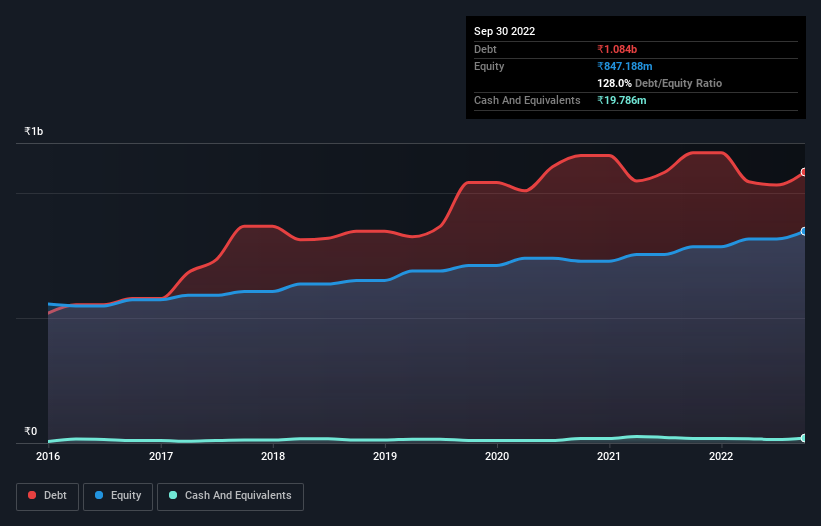[ad_1]
The external fund manager backed by Berkshire Hathaway’s Charlie Munger, Li Lu, makes no bones about it when he says ‘The biggest investment risk is not the volatility of prices, but whether you will suffer a permanent loss of capital.’ It’s only natural to consider a company’s balance sheet when you examine how risky it is, since debt is often involved when a business collapses. As with many other companies Bhandari Hosiery Exports Limited (NSE:BHANDARI) makes use of debt. But should shareholders be worried about its use of debt?
What Risk Does Debt Bring?
Debt and other liabilities become risky for a business when it cannot easily fulfill those obligations, either with free cash flow or by raising capital at an attractive price. Ultimately, if the company can’t fulfill its legal obligations to repay debt, shareholders could walk away with nothing. However, a more common (but still painful) scenario is that it has to raise new equity capital at a low price, thus permanently diluting shareholders. Of course, plenty of companies use debt to fund growth, without any negative consequences. When we think about a company’s use of debt, we first look at cash and debt together.
Check out our latest analysis for Bhandari Hosiery Exports
How Much Debt Does Bhandari Hosiery Exports Carry?
You can click the graphic below for the historical numbers, but it shows that Bhandari Hosiery Exports had ₹1.08b of debt in September 2022, down from ₹1.16b, one year before. Net debt is about the same, since the it doesn’t have much cash.

A Look At Bhandari Hosiery Exports’ Liabilities
Zooming in on the latest balance sheet data, we can see that Bhandari Hosiery Exports had liabilities of ₹931.6m due within 12 months and liabilities of ₹404.8m due beyond that. Offsetting these obligations, it had cash of ₹19.8m as well as receivables valued at ₹679.0m due within 12 months. So its liabilities outweigh the sum of its cash and (near-term) receivables by ₹637.6m.
This is a mountain of leverage relative to its market capitalization of ₹861.6m. Should its lenders demand that it shore up the balance sheet, shareholders would likely face severe dilution.
In order to size up a company’s debt relative to its earnings, we calculate its net debt divided by its earnings before interest, tax, depreciation, and amortization (EBITDA) and its earnings before interest and tax (EBIT) divided by its interest expense (its interest cover). This way, we consider both the absolute quantum of the debt, as well as the interest rates paid on it.
While Bhandari Hosiery Exports’s debt to EBITDA ratio (4.7) suggests that it uses some debt, its interest cover is very weak, at 1.8, suggesting high leverage. It seems clear that the cost of borrowing money is negatively impacting returns for shareholders, of late. Even more troubling is the fact that Bhandari Hosiery Exports actually let its EBIT decrease by 2.9% over the last year. If it keeps going like that paying off its debt will be like running on a treadmill — a lot of effort for not much advancement. When analysing debt levels, the balance sheet is the obvious place to start. But it is Bhandari Hosiery Exports’s earnings that will influence how the balance sheet holds up in the future. So when considering debt, it’s definitely worth looking at the earnings trend. Click here for an interactive snapshot.
But our final consideration is also important, because a company cannot pay debt with paper profits; it needs cold hard cash. So we clearly need to look at whether that EBIT is leading to corresponding free cash flow. Over the last three years, Bhandari Hosiery Exports recorded negative free cash flow, in total. Debt is far more risky for companies with unreliable free cash flow, so shareholders should be hoping that the past expenditure will produce free cash flow in the future.
Our View
On the face of it, Bhandari Hosiery Exports’s interest cover left us tentative about the stock, and its conversion of EBIT to free cash flow was no more enticing than the one empty restaurant on the busiest night of the year. But at least its EBIT growth rate is not so bad. Overall, it seems to us that Bhandari Hosiery Exports’s balance sheet is really quite a risk to the business. So we’re almost as wary of this stock as a hungry kitten is about falling into its owner’s fish pond: once bitten, twice shy, as they say. There’s no doubt that we learn most about debt from the balance sheet. However, not all investment risk resides within the balance sheet – far from it. Be aware that Bhandari Hosiery Exports is showing 3 warning signs in our investment analysis , and 2 of those don’t sit too well with us…
If, after all that, you’re more interested in a fast growing company with a rock-solid balance sheet, then check out our list of net cash growth stocks without delay.
Valuation is complex, but we’re helping make it simple.
Find out whether Bhandari Hosiery Exports is potentially over or undervalued by checking out our comprehensive analysis, which includes fair value estimates, risks and warnings, dividends, insider transactions and financial health.
View the Free Analysis
Have feedback on this article? Concerned about the content? Get in touch with us directly. Alternatively, email editorial-team (at) simplywallst.com.
This article by Simply Wall St is general in nature. We provide commentary based on historical data and analyst forecasts only using an unbiased methodology and our articles are not intended to be financial advice. It does not constitute a recommendation to buy or sell any stock, and does not take account of your objectives, or your financial situation. We aim to bring you long-term focused analysis driven by fundamental data. Note that our analysis may not factor in the latest price-sensitive company announcements or qualitative material. Simply Wall St has no position in any stocks mentioned.
[ad_2]
Source link








